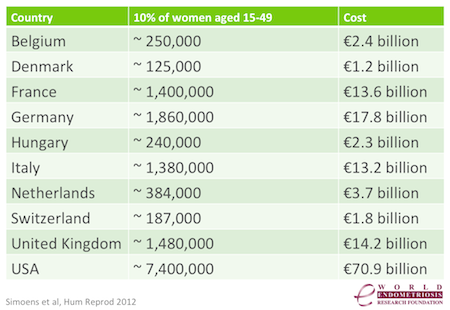The first ever prospective study of the actual cost of endometriosis shows that loss of productivity, due to pain, is twice that of direct health care costs.
The World Endometriosis Research Foundation’s EndoCost study included 909 women with a diagnosis of endometriosis from 12 centres* in ten countries [1].
Over a two-month period these women filled in validated questionnaires in their own language assessing the impact of endometriosis on their lives, including questions on a number of subjects such as health care costs, work loss, and quality of life [2].
A study like this, prospectively investigating the direct and indirect cost of endometriosis, has never been undertaken before, and we now have a much clearer picture of the actual cost of this potentially devastating disease
said principal investigator, Professor Steven Simoens. The study was unique in that gynaecologists in each participating centres worked in parallel with health economists in each of the countries to calculate to actual cost of endometriosis.
The cost of endometriosis
The average cost of endometriosis is €9,579 per woman – per year. This breaks down to an average €6,298 lost in work productivity and an average €3,113 for direct health care costs. In other words: the cost of inability to work, due to symptoms, is twice that of the direct health costs!
Health care costs were mainly due to:
- surgery (29%)
- monitoring tests (19%)
- hospitalization (18%), and
- physician visits (16%).
It is estimated that 10% of all women of reproductive age have endometriosis [3,4], which would mean that the annual cost of endometriosis in the ten participating countries is estimated as follows:
High cost, little investment
The WERF EndoCost study, which was published this month in Human Reproduction [1], showed that the cost of of endometriosis is similar to that of diabetes, Crohn’s disease, and rheumatoid arthritis.
Yet, unlike these other well-known diseases, we see relatively little investment in research into the cause and disease mechanisms in endometriosis
said the Chief Executive of the World Endometriosis Research Foundation, Lone Hummelshoj, who is shocked by how much money is being lost by governments and health care systems who ignore endometriosis.
Decreased quality of life was the most important predictor of direct health care and total costs. Costs were greater with increasing severity of endometriosis and the presence of pelvic pain.
Loss of productivity due to the symptoms of endometriosis was also demonstrated in WERF’s Global Study of Women’s Health (GSWH), published last year in Fertility and Sterility [5], showing an average loss of productivity of 11 hours a week in women with endometriosis. Like the WERF EndoCost study, this loss of productivity was driven by pain and a consequent decrease in quality of life.
The World Endometriosis Research Foundation (WERF) works to raise sufficient funds to investigate disease mechanisms to improve treatments for endometriosis so that this vicious cycle can be halted for the next generation of women.
* THE ENDOCOST CONSORTIUM
The EndoCost Consortium comprise: Leuven University (Belgium); Glostrup Hospital (Denmark); CHU de Clermont Ferrand (France); KEZ-Berlin (Germany); Medizinische Hochshule Hannover (Germany); Semelweis University (Hungary); University of Milano (Italy); University of Bern (Switzerland); University of Edinburgh (United Kingdom); The Cleveland Clinic (USA); University of Wisconsin-Madison (USA); University of Maastricht (The Netherlands).
REFERENCES
- Simoens S, et al. The burden of endometriosis: costs and quality of life of women with endometriosis and treated in referral centres. Hum Reprod 2012 [epub ahead of publication]
- Simoens S, et al. Endometriosis cost assessment (the EndoCost study): a cost-of-illness study protocol. Gynecol Obstet Invest 2011;71(3):170-6
- Rogers PA, et al. Priorities for endometriosis research: recommendations from an international consensus workshop. Reprod Sci 2009;16(4):335-46
- Adamson GD, et al. Creating solutions in endometriosis: global collaboration through the World Endometriosis Research Foundation. J of Endometriosis 2010;2(1):3-6
- Nnoaham KE, et al. Impact of endometriosis on quality of life and work productivity: a multicenter study across ten countries. Fertil Steril 2011;96(2):366-373
SEE ALSO
→ More about WERF’s EndoCost study and participating centres
→ Donate to the work of the World Endometriosis Research Foundation




